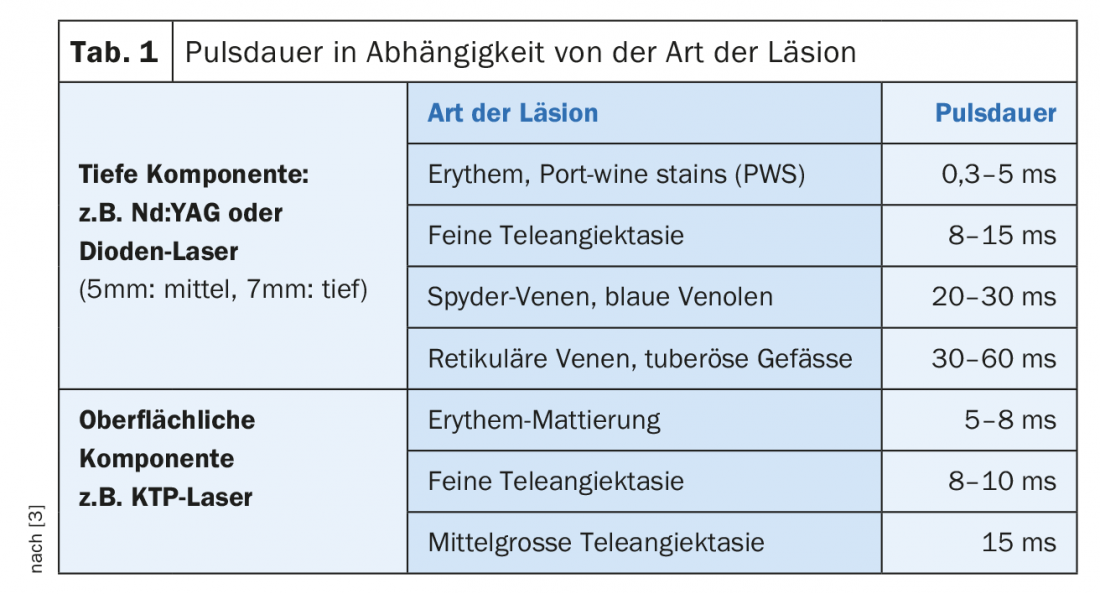Modern laser systems have an indispensable role in the therapy of vascular malformations. New technological developments make choosing the right device a challenge. What to look for to get the best results?
According to Dr. Antonio Campo Voegeli, Medical Director of Clinica Dermatologica Campo-Optimage in Barcelona, the following should be considered when selecting an adequate laser treatment: For superficial small lesions, either devices with short wavelengths (dye laser (PDL), potassium titanyl phosphate laser (KTP), flash lamp laser (IPL) or those with long wavelengths and small spot size (diodes, alexandrites, Nd:YAG) are suitable. For deep large lesions, diode and Nd:YAG lasers are best. The pulse duration varies depending on the type of lesion (Table 1).

For the choice of the energy density (“fluence”, J/cm²) one can follow the following scheme:
- low “fluence”: large, thick lesions; dark red or purple lesions, large vascular volumes
- high “fluence”: small, thin lesions; bright red or pink lesions, small vascular volumes
Next-generation lasers (more powerful laser diodes, simultaneous application of multiple wavelengths) are already successfully applied in the field of hair removal and will be applicable to the field of vascular lesions in the future, according to the prediction in a review published in 2018 [1]. Argon lasers, on the other hand, have lost importance due to side effects (scarring, long-lasting hyperpigmentation) [1].
Side effect management
Dr. Campo Voegeli summarizes the post-treatment measures to minimize adverse effects in laser therapy of vascular lesions as follows:
- Cooling measures (very important); following the treatment.
- specific topical preparations; for 2-3 days
- Aloe gel, topical steroids, plus possibly antibiotic ointment.
- if bruise forms: topical vitamin K products
- Sun-protective preparations; for 7-10 days (face) respectively 2-3 months (legs)
- Follow-up visits; during 4-8 weeks (in case of leg veins 8-12 weeks).
Common transient secondary reactions include: Erythema, pain (usually lasting only a few seconds, sometimes longer), burning sensation (usually only a few seconds), and blistering/scarring and hypo/hyperpigmentation. In case of aggressive procedure and/or high vascular density, edema may occur. Risk factors for hemosiderotic pigmentation, in addition to sun exposure, are deep vessels or a very high density of superficial vessels. Small skin hemorrhages may occur if very small vessels are treated with short pulse duration and high energy density (“fluence”). In vascular lesions of leg veins, pigmentation is possible as a side effect for a period of two to four months. Consistent UV protection can reduce the risk of postinflammatory hyperpigmentation [2]. Cooling measures following treatment are essential to reduce swelling and pain.
Source: SGML Lasers&Procedures, January 17, 2019, Zurich
Literature:
- Paasch U, Grunewald S: 2018 update on dermatologic laser therapy: Part 1 – epilation, vascular lesions and pigments. Journal of the German Society of Dermatology 2018; 16(12): 1417-1423.
- Rümmelein B: The considered post-treatment skin care after laser therapy. Certified advanced training. Skin 2014; 6: 232-238. www.dr-ruemmelein.ch/images/dokumente
- Campo Voegeli A: Slide presentation: Vascular laser treatments. A. Campo Voegeli, MD. SGML Laser&Procedures, January 17, 2019, Zurich.
DERMATOLOGIE PRAXIS 2019; 29(1): 34











